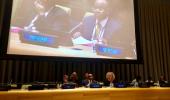
On International Day, UN renews call for global elimination of nuclear weapons
26 September 2016 – The world faces growing nuclear dangers and tensions, yet progress in multilateral nuclear disarmament has come to a “standstill,” United Nations Secretary-General Ban Ki-moon declared today, reiterating a call for complete global nuclear disarmament as the international community marks the International Day for the Total Elimination of Nuclear Weapons.
“Let us pledge to work for the total elimination of nuclear weapons with urgency and a sense of collective purpose. Our very survival depends upon it,” Mr. Ban said in a message to mark the Day, observed annually on 26 September.
Noting that nuclear disarmament is one of the founding principles of the UN, the Secretary-General said that it was also the objective of the first General Assembly resolution.
“Disarmament is in our DNA,” he stated, adding that he has been proud to advance the goal of a world free of nuclear weapons, such as by launching, in 2008, a Five Point Proposal on Nuclear Disarmament to spur Member States to greater action.
“Sadly, many countries continue to include nuclear deterrence in their security doctrines. But recent developments have shown that nuclear weapons do not ensure peace and security. Rather, their development and possession has become a major source of international tension,” the UN chief said.
“As we scan the global horizon, we face growing nuclear dangers. Progress in multilateral nuclear disarmament has come to a standstill,” he added.
The Secretary-General noted that tens of billions of dollars have been pledged to maintain and upgrade nuclear weapon systems, and one country – the Democratic People’s Republic of Korea – has “repeatedly defied the norm against nuclear testing and the will of the international community in the reckless pursuit of nuclear and ballistic missile capabilities.”
He added that there are growing divisions on the future of multilateral nuclear disarmament. The next review cycle of the Treaty on the Non-Proliferation of Nuclear Weapons begins in 2017, and “the world cannot afford another round of inaction,” Mr. Ban said.
A landmark international treaty opened for signature in 1968, the Treaty on the Non-Proliferation of Nuclear Weapons entered into force in 1970, and was extended indefinitely on 11 May 1995. Its objective is to prevent the spread of nuclear weapons and weapons technology, promote cooperation in the peaceful uses of nuclear energy, and further the goal of achieving nuclear disarmament and general and complete disarmament. It represents the only binding commitment in a multilateral treaty to the goal of disarmament by the nuclear-weapon States.
“There are many paths to a world free of nuclear weapons. What matters is that all States act now, without delay, to fulfil their disarmament and non-proliferation commitments,” the Secretary-General emphasized.
In related news, at a high-level informal plenary meeting in the General Assembly today to commemorate and promote the Day, Deputy Secretary-General Jan Eliasson highlighted that next February, the world will celebrate the 50th anniversary of the Treaty for the Prohibition of Nuclear Weapons in Latin America and the Caribbean, known as the Tlatelolco Treaty.
“This landmark treaty was the first to prohibit nuclear weapons in a densely populated region. It has served as a model and inspiration for future nuclear-weapon-free zones,” said Mr. Eliasson, who spoke on behalf of the Secretary-General.
Noting that the international community marked the twentieth anniversary of the opening for signature of the Comprehensive Nuclear-Test-Ban Treaty (CTBT) this past week, Mr. Eliasson reiterated that the Secretary-General strongly supports all efforts to uphold the international norm against nuclear testing, pending the Treaty’s entry into force.
In addition, Mr. Eliasson noted that one day before the anniversary, the Security Council adopted a resolution in support of the Treaty, with the Secretary-General acknowledging the commitment of nuclear-weapon States to uphold their moratorium on nuclear tests.
“But this resolution is not a substitute for the entry into force of the CTBT. Rather, it is a wake-up call for the need to accelerate our efforts towards the full implementation of the Treaty,” he said.
Adopted by the General Assembly under resolution 50 (1996), the CTBT – which bans all nuclear explosions for both civilian and military purposes – has been signed by 183 States thus far, and 166 States have deposited their instruments of ratification.
The Treaty will enter into force 180 days after the date of deposit of the instruments of ratification by all States listed in its Annex 2. Of the 44 States listed in Annex 2, 41 have signed and 36 have both signed and ratified the Treaty, including several nuclear weapons States.
Of the 44 States included in Annex 2, all have signed with the exceptions of the Democratic People’s Republic of Korea, India and Pakistan. Five of the 44 Annex 2 States have signed but not ratified the Treaty: China, Egypt, Iran, Israel and the United States.
The International Day for the Total Elimination of Nuclear Weapons was established by the UN General Assembly in 2013 in a resolution calling for the “urgent commencement of negotiations in the Conference on Disarmament of a comprehensive convention on nuclear weapons to prohibit their possession, development, production, acquisition, testing, stockpiling, transfer and use or threat of use, and to provide for their destruction.”
Today’s high-level meeting was convened by the President of the General Assembly in accordance with Assembly resolution 70/34 of 7 December 2015.


